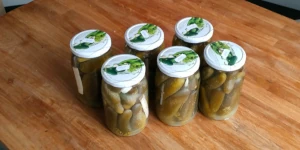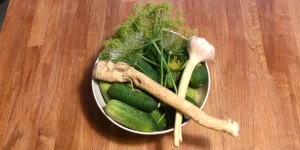
Ogórki kiszone - Polish fermented cucumbers
Jump to recipe
Fermenting cucumbers is one of the oldest food preservation methods, known in Poland for centuries. As early as the Middle Ages, chronicles mention cucumbers preserved in brine, which served as a winter food supply. Over time, they became an integral part of peasant cuisine, and later, noble and bourgeoisie.
Fermented cucumbers (ogórki kiszone) were valued not only for their long shelf life but also for their health benefits - rich in vitamin C and natural probiotics. It was thanks to them that winter in Poland, in ancient times, scurvy and other illnesses related to a lack of fresh vegetables were prevented.
In many homes, the fermenting process is a ritual. In some regions, large stoneware jars are prepared with cucumbers for winter. In others, specially prepared barrels are used. Although recipes are passed down from generation to generation, today, ordinary jars are primarily used. Regardless of the fermenting method, all methods have their own flavor (I've even heard of a bit of a dispute between enthusiasts of these methods - but I remain impartial :) ).
Although fermented cucumbers are known throughout Poland, several regions have their own varieties enriched with additives. In some regions, such pickles are additionally enriched with ingredients such as horseradish, fennel, grape leaves, or cherry leaves.
As I mentioned, fermenting cucumbers as a preservation method has a deeply rooted tradition in Poland and Central and Eastern Europe. This process involves lactic acid fermentation: bacteria convert the sugars contained in the cucumbers into lactic acid, which preserves the product and gives it its characteristic flavor. Fermenting often took place in summer and early autumn. This was a time of abundance, and vegetables were then intended to be used year-round.
Regional varieties of fermented cucumbers in Poland.
In Poland, fermenting cucumbers for winter has always been a popular way to preserve food, and every home had its own recipes. This led to the creation of many varieties that offer incredible flavor.
As many as 17 local, traditional varieties of fermented cucumbers have been registered in Poland. And that's not all. Each region or even village can have its own local recipe. Here are a few examples:
- Skalbmierskie fermented cucumbers (Świętokrzyskie Voivodeship), whose tradition dates back to the 13th century. This tradition was likely introduced here by the Tatars, but the oldest recipe dates back to 1922 (likely borrowed from the manor house in Drożejowice - https://www.gov.pl/web/rolnictwo/skalbmierskie-ogorki-kiszone ). They were added to the list of traditional products on January 14, 2014.
- Noteć fermented cucumbers (Lubusz Voivodeship) have a tradition dating back to the 1950s. Local varieties such as Polan, Śremski, and Monastyrski are used. They are sown after May 8th, which is the best time in this climate. The entire process of making these cucumbers involves layering them with leaves and spices, adding the appropriate brine, and covering them. All this is done in accordance with traditions passed down from generation to generation.
There are many more such traditions from Pomerania to the Bieszczady Mountains. Generally, however, they can be summarized as follows:
- In Greater Poland, garlic, dill, and mustard are added to the fermenting process, giving them a distinctive character. Their dark green color indicates the freshness and quality of the raw material.
- In Lesser Poland, sweet and sour fermented cucumbers are often served with meat. Sugar, spirit vinegar, and allspice are added to the brine, giving the cucumbers a slightly sweet flavor.
- In Pomerania, unique fermenting additives (sometimes less traditional) are used: kefir or sparkling water, as well as chili peppers and cherry leaves. This gives the cucumbers an exceptionally crispy, aromatic, and spicy flavor.
- In the Subcarpathian region, fermenting is done traditionally. In several localities, blackcurrant leaves play an important role, adding aroma and acidity to the cucumbers.
Fermentation Time
Lightly fermented cucumbers (małosolne) - ready after 3-5 daysMedium-fermented cucumbers - ready after 2-3 weeks
Fully fermented cucumbers for winter storage - ready after 4-6 weeks
Recipe informations:
Ingredients for 6 one-liter jars

- 3-3.5 kg (6.6-7.7 lbs) pickling cucumbers (small, firm, freshly picked)
- 6 roots of horseradish, cut into strips
- 6 sprigs of dill (ideally with seed heads)
- 6-12 garlic cloves (1-2 per jar)
- 6 blackcurrant leaves (optional, but help keep the pickles crisp)
- 6 oak or cherry leaves (optional, add extra firmness)
Brine
- 3 liters of water
- 6 tablespoons of rock salt / non-iodized salt (1 tablespoon per 0.5 liter of water)
Preparation
1. Preparing the cucumbers and jars
2. Arranging the ingredients

